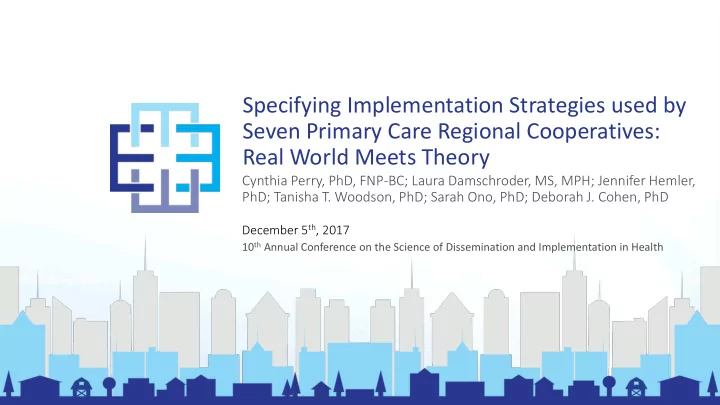

Specifying Implementation Strategies used by Seven Primary Care Regional Cooperatives: Real World Meets Theory Cynthia Perry, PhD, FNP-BC; Laura Damschroder, MS, MPH; Jennifer Hemler, PhD; Tanisha T. Woodson, PhD; Sarah Ono, PhD; Deborah J. Cohen, PhD December 5 th , 2017 10 th Annual Conference on the Science of Dissemination and Implementation in Health
Background: Implementation Support Strategies High quality health care relies on rapid dissemination and implementation of evidence into practice Relies on strategies, which encapsulate the “how to” One of the highest priorities is to develop guidance for how to choose and tailor implementation strategies for context St Strategie ies must be desc scri ribed an and operatio ionali lized Fram ameworks an and taxonomie ies have been develo loped to help lp with ith this is
Proctor Implementation Specifications Naming Defining Specifying Outcome Action Justification Actor Action Temporality Dose Affected Target Proctor, Powell & McMillen. Implementation strategies: Recommendations for specifying and reporting. implementation Science. 2013;8 (139)
ERIC Taxonomy Waltz TJ, Powell BJ, Matthieu MM, Damschroder LJ, Chinman MJ, Smith JL, et al. Use of concept mapping to characterize relationships among implementation strategies and assess their feasibility and importance: results from the Expert Recommendations for Implementing Change (ERIC) study. Implementation Science. 2015;10(109).
What’s Needed to Move Field Forward Little is known about what kinds of ground-level strategies are being used in primary care extensions to help practices make rapid change Theoretical frameworks need to be tested and refined using empirical data Some studies have applied ERIC framework and some have used specifications as outlined by Proctor and colleagues
Study Objectives 1. Identify implementation strategies used by seven regional cooperatives or extensions 2. Use data from these regional cooperatives to empirically test the Expert Recommendations for Implementing Change (ERIC) taxonomy AND guidelines for specifying and reporting implementation strategies recommended by Proctor and colleagues
Study Setting | ESCALATES
Study Setting | AHRQ EvidenceNOW Initiative
* Context Assessment
Integrated Framework | ERIC Taxonomy
Integrated Framework | ERIC Taxonomy + Specification Recommendations Put waltz and powell papers cites here
Cross Cooperative Data Matrix
Strategies used by Cooperatives 73 33 strategies used by the 7 cooperatives Across all 9 clusters 33
Interdependence Among Strategies Develop and Im De Imple lement Assess for Readiness and Too ools for or Qualit lity De Develop an and Organize Ba Barrie iers & Facil ilitators Mon onit itoring Qualit lity Mon onitorin ing Systems Use e Change Ch e De Develop Da Data Record Res esource e Sharing Agr greements Warehousing Systems Tech echniques es Provide Fund and Con Contract for th the e Clin Clinical In Innovati tion Local Loc l Tech echnic ical l Use Assis istance Data Da Exp xperts
Interdependence Among Strategies
Meta-Strategy | Practice Facilitation
Recommended Refinements to ERIC Taxonomy Refining definition and/or name for 8 strategies Develop implementation tools for quality monitoring; develop and organize quality monitoring systems; audit and feedback; change record systems; fund, contract for clinical innovation; organize clinician implementation teams meetings ; develop and distribute implementation toolkit; conduct ongoing training Adding 3 strategies Community resource engagement , create online learning communities, redesign workflow
Conclusions & Future Directions Some Strategies are not mutually exclusive Meta-strategies are comprised of discrete strategies Discrete strategies may be sequenced or tailored Some ERIC terms did not completely describe EvidenceNOW implementation activities Some definitions needed to be expanded
Conclusions & Future Directions Integration of ERIC taxonomy and Specification Recommendations Valuable to harmonize language across multiple settings/studies Useful for prospective planning and retrospective reporting Refine theory with use empirical data creates more robust theory Apply in large scale and diverse studies
Acknowledgements We would like to acknowledge the following individuals/groups for their support on this project: • PI: Dr. Deborah Cohen • EvidenceNOW Cooperatives • ESCALATES Team • Agency for Healthcare Research and Quality • Funding: R01HS023940-01 • Study website: escalates.org • Twitter: @ESCALATESorg
Recommend
More recommend